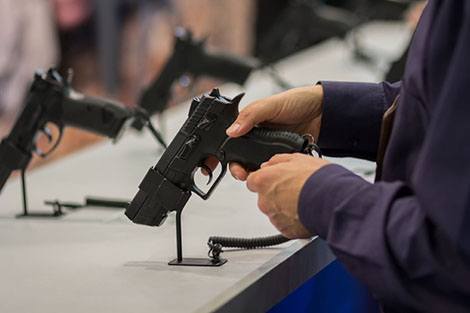January 3, 2017 – At first blush, it may seem unusual that gun shop owners, firearm instructors, and gun rights stakeholders have been joining forces with health professionals to prevent gun-related suicides.
But there’s a fledgling movement among these groups that’s gaining momentum around the U.S. With half of all suicide deaths in the U.S. related to guns, it doesn’t surprise Harvard T.H. Chan School of Public Health’s Catherine Barber that both gun owners and people in the health field are working to devise strategies to keep suicidal people away from firearms.
These sorts of coalitions didn’t exist seven years ago, but today there are suicide-prevention projects under way in more than 20 states, according to Barber, director of the Harvard Injury Control Research Center’s Means Matter project which aims to raise awareness about reducing a suicidal person’s access to lethal methods. In Utah, for example, the state curriculum for concealed carry permit seekers now includes a suicide prevention module. In Nevada, there are suicide prevention displays at gun shows. At the national level, the American Foundation for Suicide Prevention and the National Shooting Sports Foundation are working together to develop suicide prevention materials for gun owners.
Barber recently wrote about these collaborations in a viewpoint article in JAMA Internal Medicine, co-authored with Elaine Frank, former director of the Injury Prevention Center at Children’s Hospital of Dartmouth, and with Ralph Demicco, former owner of Riley’s gun shop in Hookset, N.H. and vice-president of the state’s largest gun rights group. Barber and Means Matter colleague Mary Vriniotis first began working with Frank and Demicco—co-chairs of the New Hampshire Firearm Safety Coalition—in 2009, when an ad hoc group came together to examine whether there was a role that gun shops could play in reducing suicide. The group surveyed gun shop owners and developed suicide prevention materials aimed at both owners and customers.
While pro-gun groups and people in the health field may not agree on gun laws in the U.S., they are often quick to agree on the benefits of preventing suicide, said Barber. “It really doesn’t matter what your political ideology is or whether you’re an avid gun rights supporter,” she said. “When it comes to preventing firearm suicides, there’s tremendous common ground.”
She noted that many pro-gun groups have a strong ethic about promoting the responsible handling of firearms, preventing unintentional shootings, protecting their families, and ensuring that neighbors look out for neighbors. “All of those things dovetail with suicide prevention,” Barber said, adding that pro-gun groups also want to prevent guns from “getting a bad name, so they’re very happy to get out in front on this issue.”
Studies show that gun owners and their families are at higher risk of suicide than those who don’t own guns. While gun owners aren’t more likely than non-gun owners to have a mental health problem or to attempt suicide, their attempts are more likely to prove fatal because they are more likely to involve a gun. But if there’s a way to keep guns away from those who are suicidal—for example, by temporarily storing household firearms away from a vulnerable person’s home until he or she recovers—it could save lives, Barber said. Many suicidal crises are temporary, and 90% of those who attempt suicide and survive don’t go on to later take their lives—even those who make very serious attempts.
“Trying to keep guns out of the hands of people who may be suicidal isn’t going to protect everybody—some will manage to kill themselves in other ways,” Barber said. But since nearly everything a person would substitute is less likely to kill them, this is one of the simpler ways to save lives. “Plus it’s a good ‘bro’ way to show you care,” she added. “Often guys don’t feel comfortable asking a friend in distress how they can help. But saying ‘How about I hold onto your guns while you’re going through this?’ is a concrete way to lend a hand.”
photo: iStock
